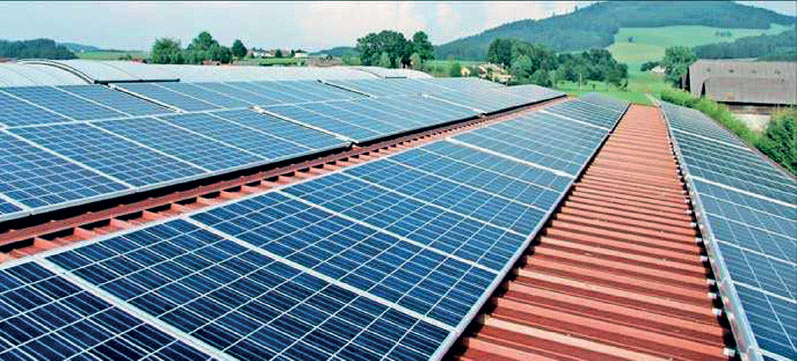Thursday Oct 02, 2025
Thursday Oct 02, 2025
Monday, 14 July 2025 00:01 - - {{hitsCtrl.values.hits}}

Sri Lanka’s solar transition, once a global example of rapid adoption, now stands at a crossroads
By Jeremy Fernando
Introduction
Sri Lanka’s renewable energy journey saw a rapid boost with the launch of Surya Bala Sangramaya (Battle for Solar Energy) in 2016, a Government initiative to encourage rooftop solar installations. Enabled by Net Metering, Net Accounting and Net Plus policies, rooftop and ground-mounted solar systems expanded rapidly. By early 2024, rooftop solar installations in Sri Lanka had exceeded 750 MW, and by May 2025, total rooftop capacity reached approximately 1,700 MW. This surge reflects the rapid adoption of distributed solar generation, making rooftop solar the dominant contributor to the country’s overall installed solar capacity.However, this growth came with unintended consequences, particularly for grid stability and financial viability. As solar generation peaked during midday when demand is relatively low, the Ceylon Electricity Board (CEB) faced mounting technical and economic pressures. This has prompted the Government of Sri Lanka (GoSL) to consider reforms aimed at shifting solar exports from daytime to evening hours, mirroring global trends but raising alarm among local stakeholders.
The policy shift
In response, the Government of Sri Lanka (GoSL) is planning to restructure export tariffs to reflect the time-value of solar energy:
The rationale aligns with international experience: countries such as Australia, Germany, and California have faced similar issues and are now incentivising energy storage and self-consumption over grid export. This evolution marks a shift toward firm solar energy, renewable energy that can be dispatched reliably, often using battery energy storage systems (BESS).
The unspoken truth: Grid saturation
One of the least discussed but most critical technical facts is that Sri Lanka’s daytime solar exports have now saturated the grid’s capability to absorb distributed energy. In simpler terms, we are producing more solar energy than the grid can technically handle during daylight hours.
This is not merely a case of ‘instability’ as often claimed, but a fundamental limit in the grid’s design, which was originally built for centralised generation and downstream distribution, not for widespread consumer-level energy generation. This is a primary reason why the GoSL must shift solar export incentives to the evening peak.
Net metering and accounting: A double-edged sword
Net Metering and Net Accounting mechanisms originally played a vital role in making solar viable. They allowed prosumers to “store” excess solar in the grid and draw it later, essentially using the grid as a free virtual battery.
While effective in promoting adoption, these schemes eventually placed financial strain on the utility. The cost of maintaining grid infrastructure, balancing demand, and ensuring 24/7 availability fell disproportionately on non-solar users and the state.
The GoSL’s current position is that solar producers should invest in their own storage and shift towards self-consumption. While technically sound, this approach transfers the cost burden to consumers, raising equity and feasibility concerns.
Prosumers feel the pinch
While the policy shift is rational, it affects Prosumers (producers and consumers), early adopters and EPCs significantly:
1.ROI concerns: Investments were made based on prior tariff structures. Drastic tariff changes will affect project viability of already planned projects under current business models.
2.Perceived biases: There are growing allegations that CEB is favouring diesel generator (DG)-based suppliers over clean energy, stoking distrust in the transition narrative.
The way forward: A balanced strategy
To safeguard the long-term contribution of solar energy in Sri Lanka’s power sector while addressing existing grid limitations, the Government should implement a balanced and forward-looking policy framework.
Introduce a peak export tariff: Prosumers with storage and capable of evening peak exports, should be compensated adequately, at least Rs. 60 per unit for evening peak exports.
Define firm energy export schemes: Ground-mounted solar plants that integrate BESS should be allowed to sell firm energy under fixed long-term contracts.
Duty and VAT waiver: Remove duty and VAT on LiFePO4 battery Cells, Solar Panels and Hybrid Inverters to encourage adoption of solar plus storage with peak exports under ToU tariff structure
Encourage local innovation: Support technologies and companies that enable hybrid inverter retrofits, IoT monitoring, and seamless storage integration.
Reducing cost of electricity through solar self-consumption
Increasing solar self-consumption reduces the need for fossil fuel imports, which are the primary source of energy for peak-hour generation. This not only contributes to environmental goals but also has a direct impact on reducing the cost of electricity production. At present, the cost of electricity is highest during the evening peak, when fossil fuels are predominantly used.
Therefore, one practical way the Government can reduce the cost of electricity in the short term is by minimising peak consumption, especially by encouraging battery-backed solar systems that export power during peak hours. Over the long term, GoSL’s strategy to reduce electricity costs must incorporate all measures that contribute to lowering the cost of generation, that includes encouraging firm renewable energy supply and reducing fossil dependency.
Conclusion
Sri Lanka’s solar transition, once a global example of rapid adoption, now stands at a crossroads. As grid limitations become a bottleneck and policy priorities shift, it is essential that we recognise the true technical challenges, particularly the oversaturation of daytime exports, and address them with data-driven, equitable strategies.
With the right balance of incentives, infrastructure upgrades, and support for consumer-owned storage, Sri Lanka can ensure that its solar future remains bright and sustainable.
(The writer is an Innovator and Patent holder for Energy Storage Systems (ESS), currently engaged as a freelance Consultant on ESS. He can be contacted on [email protected] - https://www.linkedin.com/in/jeremy-fernando-miet-uk-24a385158/.)